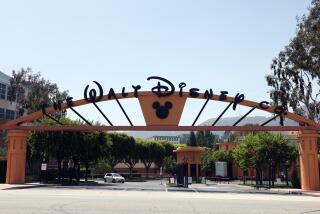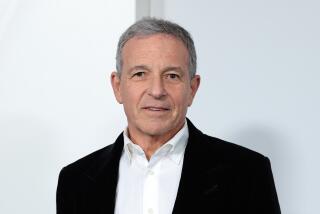Bob Iger reveals how his Pixar gamble helped save Disney

Walt Disney Co. Chairman and Chief Executive Bob Iger’s new book “The Ride of a Lifetime” opens with a description of his 2016 trip to China for the unveiling of the company’s Shanghai theme park. During the visit, the executive learned of two horrific tragedies: The shooting at the Pulse nightclub in Orlando, Fla., in which two part-time Disney employees died, and an alligator attack on the beach at Disney’s Grand Floridian Resort and Spa that killed a 2-year-old boy.
While the opening of a new park still marked “a happy day” for the company, Iger acknowledges, it was “one of the saddest of my career.”
Such are the extraordinary highs and lows that come with being one of the world’s most powerful media executives.
“The Ride of a Lifetime” — part memoir, part business book — describes Iger’s rise from his job as an ABC studio supervisor to becoming the executive who would lead Disney’s blockbuster acquisitions of Pixar Animation Studios, Marvel Entertainment, Lucasfilm and eventually 21st Century Fox Inc.
The 68-year-old Iger weaves leadership advice between anecdotes spanning the darkest days of the Michael Eisner era, controversies surrounding Pixar and Disney Animation Chief Creative Officer John Lasseter and comedian Roseanne Barr, and dealing with powerful figures such as Marvel Chairman Isaac Perlmutter.
Here are five takeaways:
After Eisner
The corporate battle that ended Eisner’s two-decade tenure as Disney’s CEO is one of the media industry’s best-known tales of corporate strife. But Iger retells that history from his own perspective, doing so with respect for his predecessor and former boss. (Iger was chief operating officer under Eisner for five years.) He admiringly describes how Eisner went on his own company’s show “Nightline” to face questions from Ted Koppel after a humiliating public rebuke from shareholders who were rallied against him by Roy E. Disney.
In vying to replace Eisner, Iger had to walk a fine line. Disney and others were looking for change, but giving the keys to Iger, Eisner’s No. 2, “didn’t exactly signal a new day,” he admits. But with the advice of consultant Scott Miller, Iger decided to win the board members to his side by looking to the future, rather than defending or criticizing Eisner. (Iger also notes how Eisner once told board directors at a dinner that Iger would never be his successor.)
After he got the top Disney job, he also wanted to bury the hatchet with Disney, the nephew of the company’s co-founder, another move that required some finesse. “[Eisner] wasn’t happy to hear that I was offering an olive branch to Roy, but he acknowledged that peace with him was important,” Iger writes.
‘Star Wars’ disturbance
Iger acknowledges getting it wrong once in a while. Just look at the company’s early handling of George Lucas.
When Disney bought Lucasfilm in 2012, it also acquired Lucas’ script outlines for three “Star Wars” movies, which the company did not ultimately use for the Skywalker saga’s continuation. Iger describes a tense meeting in which Lucasfilm head Kathleen Kennedy took director J.J. Abrams and writer Michael Arndt to meet with Lucas in Northern California.
The “Star Wars” creator became upset when they described their ideas for the plot. Though Iger says he’d been careful not to mislead Lucas about Disney’s intentions, he acknowledges Lucas had taken Disney’s purchase of his treatments as “a tacit promise” that they would be used.
“I could have talked through this with him and possibly avoided angering him by not surprising him,” Iger writes. “Now, in the first meeting with him about the future of ‘Star Wars,’ George felt betrayed, and while this whole process would never have been easy for him, we’d gotten off to an unnecessarily rocky start.”
Steve Jobs and ‘boldness’
Disney’s lucrative relationship with Pixar founder Steve Jobs was hanging by a thread when Iger took over, but the executive quickly took action to repair the damage. One major step was Iger’s willingness to put Disney shows on iTunes and allow them to be shown on iPod video screens. “Steve responded to boldness, and I wanted to signal to him that there could be a different way of doing business with Disney going forward,” Iger writes.
That eventually led to an even bolder idea: buying Pixar. Iger recalls breaking out in a sweat when making the first overture to Jobs over the phone, thinking that he would probably be rejected outright. Later, the two execs met at Apple’s Cupertino, Calif., headquarters to hash out the idea.
Iger struggled to win over the board to the proposed $7.4-billion deal, which was opposed by none other than the ousted Eisner, who clashed with Jobs. Eisner would later admit being wrong about Pixar, “which was gracious of him,” Iger said.
Workplace bullying
One of the most remarkable passages covering Iger’s early career involves an instance of inappropriate workplace behavior he experienced when he was much lower in the food chain at ABC, where he began working in 1974 (before it was owned by Disney). He describes the incident as an example of the “casual abuse” that in today’s environment would get people fired.
One of his responsibilities, when working on “The ABC Evening News With Harry Reasoner,” was to wait while the producer reviewed the show for fixes before it aired in later time zones. “I ventured into the control room and said, ‘Harry sent me to find out how it looks,’” he writes. “The producer looked at me with complete disdain. Then he unzipped his pants, pulled out his penis, and replied, ‘I don’t know. You tell me how it looks.’ Forty-five years later, I still get angry when I recall that scene.”
Almost buying Twitter
By fall 2016, Disney had “virtually closed a deal” to buy Twitter, with the boards of both companies in support, Iger writes. However, he said, he decided at the last minute to back out.
Iger thought the social media company could be a “powerful platform” for Disney. However, challenges abounded and Iger worried about Twitter’s failure to combat hate speech and fake accounts influencing political elections.
“Those would become our problems,” he said, adding that the rampant issues “would be corrosive to the Disney brand.”
More to Read
Sign up for our Book Club newsletter
Get the latest news, events and more from the Los Angeles Times Book Club, and help us get L.A. reading and talking.
You may occasionally receive promotional content from the Los Angeles Times.









